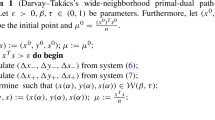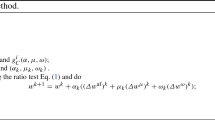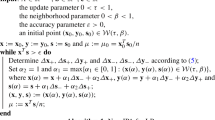Abstract
In this paper, we propose a primal-dual second-order corrector interior point algorithm for linear programming problems. At each iteration, the method computes a corrector direction in addition to the Ai–Zhang direction [Ai and Zhang in SIAM J Optim 16:400–417 (2005)], in an attempt to improve performance. The corrector is multiplied by the square of the step-size in the expression of the new iterate. We prove that the use of the corrector step does not cause any loss in the worst-case complexity of the algorithm. To our best knowledge, this is the first wide neighborhood second-order corrector algorithm enjoyed the low iteration bound of \({O(\sqrt{n}L)}\), the same as the best known complexity results for interior point methods.
Similar content being viewed by others
References
Ai W.: Neighborhood-following algorithms for linear programming. Sci. China Ser. A. 47, 812–820 (2004)
Ai W., Zhang S.: An \({O(\sqrt{n}L)}\) iteration primal-dual path-following method, based on wide neighborhoods and large updates, for monotone LCP. SIAM J. Optim. 16, 400–417 (2005)
Cartis C.: Some disadvantages of a Mehrotra-tpye primal-dual corrector interior point algorithm for linear programming. Appl. Numer. Math. 59, 1110–1119 (2009)
Cartis, C.: On the convergence of a primal-dual second-order corrector interior point algorithm for linear programming. Technical report, Numerical Analysis Group, Computing Laboratory, Oxford University. April 2005. http://www.optimization-online.org/DB_HTML/2005/03/1097.html
Floudas C.A., Pardalos P.M.: Encyclopedia of optimization, 2nd edn. Springer, New York (2009)
Freund R.M., Mizuno S.: Interior point methods: current status and future directions. In: Frenk, J.B.G., Roos, C., Terlaky, T., Zhang, S. (eds) High Performance Optimization, pp. 441–446. Kluwer, Dordrecht (2000)
Gondzio J.: Multiple centrality corrections in a primal-dual method for linear programming. Comput. Optim. Appl. 6, 137–156 (1996)
Gonzaga C.C.: Path-following methods for linear programming. SIAM Rev. 34, 167–224 (1992)
Kojima M., Megiddo N., Mizuno S.: A primal-dual infeasible-interior-point algorithm for linear programming. Math. Program. 61, 263–280 (1993)
Kojima M., Mizuno S., Yoshise A.: A primal-dual interior point algorithm for linear programming. In: Megiddo, N. (ed.) Progress in Mathematical Programming: Interior Point and Related Methods, pp. 29–47. Springer, New York (1989)
Mehrotra S.: On finding a vertex solution using interior point methods. Linear Algebra Appl. 152, 233–253 (1991)
Mehrotra S.: On the implementation of a primal-dual interior point method. SIAM J. Optim. 2, 575–601 (1992)
Nematollahi E., Terlaky T.: A simpler and tighter redundant Klee-Minty construction. Optim. Lett. 2, 403–414 (2008)
NETLIB: A Repository of Linear Programming Test Problems. http://www.netlib.org/
Nocedal J., Wright S.J.: Numerical Optimization. Springer, New York (1999)
Pardalos P.M., Wolkowicz H.: Topics in Semidefinite and Interior-Point Methods. American Math Society, Providence (1998)
Potra F.A., Wright S.J.: Interior-point methods. J. Comput. Appl. Math. 124, 281–302 (2000)
Roos C., Terlaky T., Vial J.-Ph.: Theory and Algorithms for Linear Optimization: An Interior Point Approach. Wiley, Chichester (1997)
Salahi M., Mahdavi-Amiri N.: Polynomial time second order Mehrotra-type predictor–corrector algorithms. Appl. Math. Comput. 183, 646–658 (2006)
Salahi M., Peng J., Terlaky T.: On Mehrotra-type predictor–corrector algorithms. SIAM J. Optim. 18, 1377–1397 (2007)
Salahi M., Terlaky T.: Postponing the choice of the barrier parameter in Mehrotra-type predictor–corrector algorithms. Eur. J. Oper. Res. 182, 502–513 (2007)
Wright S.J.: Primal-Dual Interior-Point Methods. SIAM, Philadelphia (1997)
Ye Y., Todd M.J., Mizuno S.: An \({O(\sqrt{n}L)}\)-iteration homogeneous and self-dual linear programming algorithm. Math. Oper. Res. 19, 53–67 (1994)
Zhang Y., Zhang D.T.: On polynomiality of the Mehrotra-type predictor–corrector interior-point algorithms. Math. Program. 68, 303–318 (1995)
Author information
Authors and Affiliations
Corresponding author
Rights and permissions
About this article
Cite this article
Liu, C., Liu, H. & Cong, W. An \({O(\sqrt{n}L)}\) iteration primal-dual second-order corrector algorithm for linear programming. Optim Lett 5, 729–743 (2011). https://doi.org/10.1007/s11590-010-0242-6
Received:
Accepted:
Published:
Issue Date:
DOI: https://doi.org/10.1007/s11590-010-0242-6




